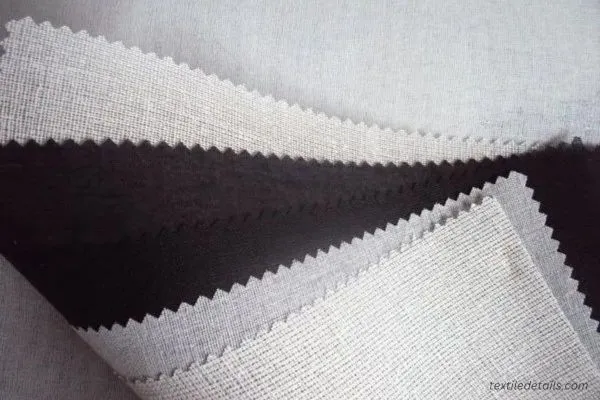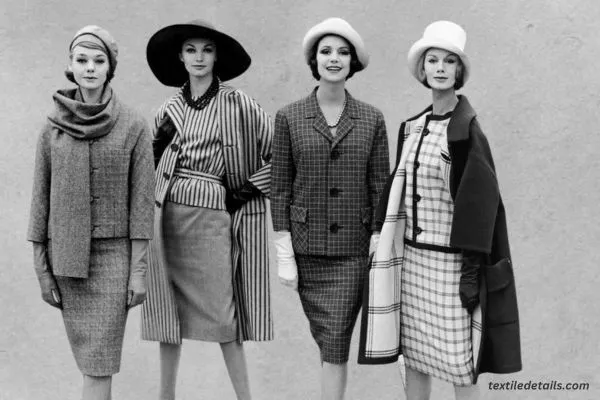Those new in the textile field often ask, what is interlining? In the production of clothing, interlining is a crucial component. One type of accessory inserted between two fabric layers that make up clothing type is called interlining. The term “interlining” refers to a type of fabric sewn or fused in between two layers of another fabric to maintain the intended form of different parts of an article of clothing.

Table of Contents
The Objective of Interlinings
The following are some of the purposes of using interlinings.
- To provide depth, hardness, and strength to the look of shirt collars and cuffs for a more formal appearance.
- Since interlining is an insulator, soft and flexible, you can use it in winter as jackets and pants to provide a layer.
- To provide a great foundation for an embroidered logo.
- When placed behind thin materials, it provides the appearance that the fabrics are thicker and more inviting.
- The color of the garment needs to be considered while selecting the color of the interlining.
- The use of interlining makes garment sewing easier and faster.
- When used in the back of needlework, it makes the item thicker and improves the overall aesthetic.
- The wearer’s comfort depends on the interlining, which plays a role in the overall comfort of the garment.
Properties of Interlinings
There are some properties of interlining as follows:
Shearing and surface characteristics: One of the very first things a customer does is touch an article of clothing to get an idea of how the fabric will behave. When assessing the value of fused garment pieces, it is necessary to consider the features of the textile surface, which may be identified visually or through the subjective evaluation of a handle.

Fabric handling and the drape of the garment: The purchase of fabric or fused fabrics assemblies is determined by the properties of the fabric or assemblies. Psychological characteristics of a fabric’s nature can be described by its handle, which can be soft, simple, or hard, for example. It is a quantitative quality that may be described by the physical characteristics of the cloth.

Tensile and elastic characteristics: The tensile and elastic characteristics of the shell fabric impact the properties of the stabilized garment sections and determine how compatible the shell fabric is with the interlining.
Bending: The shell fabric’s bending capabilities and the interlining ensure that the stabilized garment pieces have the appropriate look and fall.
Classification of Interlining
According to the method of application
According to the method of application, two types of interlining are utilized in the garment manufacturing business. They are
- Sewn or non-fusible interlining
- Fusible interlining
Sewn: Sewn or non-fusible interlining is an interlining that is attached to the components of the garment through the use of sewing. To prepare the sewed interlining, a piece of fabric is first treated with starch, then allowed to dry, and then sewn together with the fabric.

Fusible: Fusible interlining is an interlining material that may be fused with the components of a garment with the application of heat and pressure for a specific amount of time.
According to the base cloth
According to the base cloth, there are four types of interlinings as follows:
(i) Woven interlining
(ii) Non-woven interlining
(iii) Non-general interlinings
(iv) Knitted interlining
(i) Woven Interlining
Interlining that is woven is a woven substrate foundation that is used for fusible interlining. Regions along the warp of the garment require a certain type of woven interlining. Woven interlinings created from lightweight materials are usually put to use for the garment parts that are subjected to the most strain, like jackets, waistbands, outerwear plackets, collars, front shirt bands, etc.

An interlining that has a soft grip in the warp and a hard handle in the weft is an excellent illustration of this application’s potential uses. This interlining is manufactured exclusively for the fronts of men’s jackets. It not only offers a stable foundation for the length of the front, but it also stops the lateral parts across the chest and shoulders from collapsing.

Interlinings made of woven fabric help the garment function to a very high standard. On the other hand, compared to the prices of the other available sorts, this one is very pricey.
(ii) Non-Woven
According to what the term “non-woven” says, the material is not created by weaving textile cloth. A non-woven substrate can be either a sequence of fibers or a combination of fibers. Its architecture can be any of four different types: random, parallel, cross, or composite. As a result of the different manufacturing processes, process even and interlinings often come in at a lower price than woven or knitted materials.

The highest quality of this type of interlining is created from 100% polyamide goods with ultra-fine coats to heavier mixes. These blends may be used to create a variety of different textures. These are bonded either chemically or thermally, depending on the application, and they are employed. A lack of availability of conventional textiles led to the invention of non-woven interlinings, which are utilized in the apparel manufacturing sector. These interlinings originated in the paper industry.
(iii) Non-General
- Water-Repellent Interlinings: Thermal bonding is used to create water-repellent interlinings. The base fabrics used are often non-woven and circular knits durable enough to survive the rigors of commercial washing operations. These are developed especially for use in the manufacturing of rainwear pieces.

- Hair Interlinings: A woven canvas produced from horse hair, hair interlinings are most commonly found in men’s formal coats, blazers, and other garments of this type. There are two different kinds of applications: combustible and non-combustible (sew-on). The former is secured to the Reverse side of the shell fabric by using thermal bonding or fusing, while the latter relies on stitching for its attachment. Using stronger interlinings can give the shell fabric stability, reducing creases and improving the drape and the hardness of the shell fabric.

(iv) Knit Fabric
Knitted interlinings that are fusible are typically employed in the fabrication of knit clothes because they provide the ideal stretch foundation for effective manufacturing. Interlinings made of cyclic and jersey knit fusible fabric have stretch and recovering capabilities, which allow them to be employed in stretchy merging regions.

Because it was constructed using knitted interlining, it supplied the fused components by easily yielding to motions of the torso and limbs. The increasing popularity of knitted textiles for men’s and women’s clothing in the early 1960s led to the development of knitted interlinings.

The first products were warp-knitted, and it wasn’t until then that this kind of interlining was essential. Warp-knitted textiles are used as the basic materials for fusible interlinings. Lock knitting and weft insert construction are the two forms of construction that are most commonly employed.
Conclusion
Interlining is a whole panel cut from a different layer of fabric and attached on the wrong side of the main fabric, unlike interfacing, which is employed in smaller places like collars, cuffs, and facings for reinforcement and strength. While it may be melded to the cloth, this finishing method is more often applied by hand.
Adding interlining to a garment increases the time and money essential to make the garment. To complete a sewing project, you have to know not just when and where to employ interlining, but which materials to use, and why. This guide will help you choose the right interlining for your project. It does not matter if you’re trying to give your garment more body, create more depth, or keep it from creasing.
